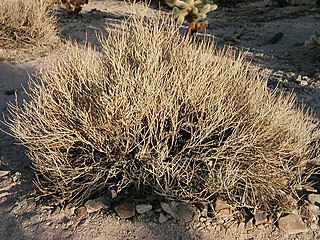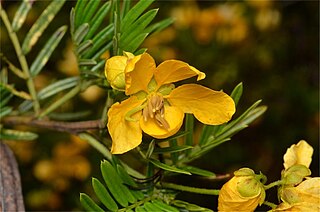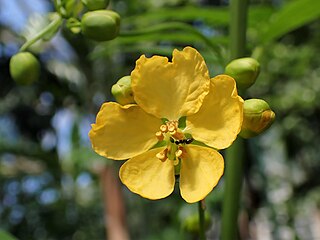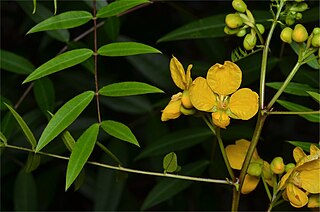
Senna covesii is a perennial subshrub in the family Fabaceae, native to the Mojave Desert and Sonoran Desert in southeastern California, southern Nevada, and Arizona in the United States, and northern Baja California in Mexico. It is found on desert plains and in sandy washes between 500 and 600 m above sea level, and is very common in Joshua Tree National Park. The specific epithet honors ornithologist Elliott Coues.

Senna artemisioides, commonly known as silver cassia, is a species of flowering plant in the family Fabaceae and is endemic to Australia, where it is found in all mainland states and territories. It is a small, woody shrub with silver-green leaves and yellow flowers.

Zanthoxylum brachyacanthum, known as thorny yellow-wood, satinwood, satin tree or scrub mulga, is a species of flowering plant in the family Rutaceae and is endemic to north-eastern Australia. It is a rainforest shrub or tree with thick, cone-shaped spines on the trunk and prickles on the branches, pinnate leaves, and male and female flowers arranged in panicles.

Senna italica, the Port Royal senna, Italian senna, or Senegal senna is a legume tree in the genus Senna. It is recognized by many other common names based on the regions it grows in. In India, it is used to produce a powder for treating hair-related diseases which is known as “neutral henna”. Whereas, in some parts of the world, this species is cultivated for the leaves which yield the drug senna, known commonly as Senna glycoside, which in turn is the base for a laxative. Senegal senna is easily distinguishable through its many distinctive features. There are 3 subspecies of this plant based on the size of the inflorescence and the length of the petiole. The subspecies are italica, micrantha, and arachoides. In many regions, this plant is cultivated commercially and medicinally.

Senna acclinis, commonly known as rainforest cassia or brush senna, is a species of flowering plant in the family Fabaceae and is endemic to near-coastal areas of eastern Australia. It is a shrub with pinnate leaves and bright golden yellow flowers in groups of two to five and long, narrow seed pods. It is similar to other species of Senna that are environmental weeds.

Zanthoxylum rhetsa, commonly known as Indian prickly ash, is a species of flowering plant in the family Rutaceae and occurs from India east to the Philippines and south to northern Australia. It is a deciduous shrub or tree with cone-shaped spines on the stems, pinnate leaves with between nine and twenty-three leaflets, panicles of white or yellowish, male and female flowers, followed by spherical red, brown or black follicles.

Boronia rivularis, commonly known as the Wide Bay boronia, is a plant in the citrus family Rutaceae and is endemic to the Wide Bay–Burnett area of eastern Queensland. It is an erect, woody shrub with pinnate leaves and white to pink, four-petalled flowers.

Boronia squamipetala is a species of plant in the citrus family, Rutaceae, and is endemic to Queensland, Australia. It is an erect shrub with pinnate leaves with between five and thirteen elliptic leaflets, and green to white, four-petalled flowers with hairy backs.

Boronia tolerans is a plant in the citrus family, Rutaceae and is endemic to a small area in the Northern Territory in Australia. It is an erect shrub with many branches, pinnate leaves and white, four-petalled flowers. It is only known from Nitmiluk National Park.

Senna pendula, also known as Easter Cassia, Christmas Senna, winter Senna, climbing Cassia, golden shower, pendant Senna and valamuerto, is a plant of the Fabaceae family with a shrub habit that is native to South America. It used in various parts of the world as an ornamental plant and is an environmental weed in Australia. The flowers are yellow and the name pendula means 'pendulous' or 'drooping'.

Senna aciphylla, commonly known as sprawling senna or Australian senna, is a species of flowering plant in the family Fabaceae and is endemic to eastern Australia. It is a sprawling shrub with pinnate leaves with eight to twelve pairs of linear to narrowly elliptic leaflets, and yellow flowers in pairs or groups of three.

Senna barclayana, commonly known as smooth senna or pepper-leaf senna, is a species of flowering plant in the family Fabaceae and is endemic to eastern Australia. It is a herbaceous perennial or subshrub with pinnate leaves with six to ten pairs of lance-shaped or narrowly elliptic leaflets, and yellow flowers in groups of six to ten.

Senna barronfieldii, commonly known as southern cassia, is a species of flowering plant in the family Fabaceae and is endemic to eastern Australia. It is an erect shrub with more or less glabrous, pinnate leaves with eight to thirteen pairs of lance-shaped or elliptic leaflets, and yellow flowers in groups of three to five.

Senna cardiosperma is a species of flowering plant in the family Fabaceae and is endemic to the western half of Australia. It is an erect shrub or small tree with pinnate leaves, the number and shape of the leaflets depending on subspecies, yellow flowers with ten fertile stamens in each flower, and flat pods.

Senna charlesiana is a species of flowering plant in the family Fabaceae and is endemic to Western Australia. It is an erect shrub with cylindrical leaves, sometimes with one or two pairs of cylindrical leaflets, and yellow flowers arranged in pairs or groups of three or four, with ten fertile stamens in each flower.

Senna circinnata, commonly known as coiled cassia, is a species of flowering plant in the family Fabaceae and is endemic to eastern Australia. It is a shrub or small tree with pinnate leaves with one to three pairs of egg-shaped leaflets, and small groups of yellow flowers in upper leaf axils.
Senna cladophylla is a species of flowering plant in the family Fabaceae and native to Western Australia and the Northern Territory. It is a perennial herb or undershrub with pinnate leaves with two or three pairs of broadly elliptic leaflets, and yellow flowers arranged in pairs, with ten fertile stamens in each flower.

Senna clavigera, commonly known as pepper leaf senna, is a species of flowering plant in the family Fabaceae and is endemic to eastern Australia. It is a perennial herb with pinnate leaves with four to seven pairs of lance-shaped to elliptic leaflets, and groups of four to twenty yellow flowers in upper leaf axils.

Senna coronilloides, commonly known as brigalow senna, is a species of flowering plant in the family Fabaceae and is endemic to eastern Australia. It is an erect, sprawling shrub with pinnate leaves with nine to twelve pairs of elliptic leaflets, and groups of three to five yellow flowers in upper leaf axils.
Senna curvistyla is a species of flowering plant in the family Fabaceae and is endemic to north-western Australia. It is an undershrub with pinnate leaves with two or three pairs of narrowly elliptic to elliptic leaflets, the flowers yellow and arranged in groups of two or three, with ten fertile stamens in each flower.



















